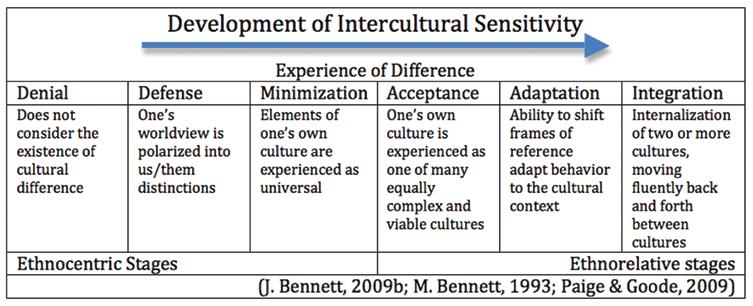
12 minute read
Challenging Assumptions: How well are international schools
EDTHOUGHT EdThought >> Challenging Assumptions: How well are international schools preparing students to succeed in an interconnected world?
The international school in Seoul, South Korea where I serve as University/ College Counselor will hold its first graduation ceremony this year. The twenty-seven members of the class of 2015 are competing with students from around the world for places at universities in a dozen countries, and they will spend their careers working in a globalized, interconnected world. For this year’s graduates, the ability to shift cultural perspectives and adapt to cultural differences will contribute greatly to their educational, professional and personal lives. But to what extent is their international school experience equipping them with these vital skills?
There has long been an assumption among international educators that in schools in which “an international curriculum is in place, then the attitude of the teaching staff and management practices in those schools will be in accord with the promotion of intercultural understanding” (Hill, 2006). But how valid is this assumption? To ensure that their students are outfitted with the knowledge, skills and attitudes necessary to effectively negotiate cultural differences, intercultural perspectives and competencies must be an integral part of the curricular and co-curricular programs offered at international schools. But how well prepared are teachers to implement these aspects of their schools’ programs? That is one of the questions that was raised as a result of research I conducted at an international school in Southeast Asia as a part of my doctoral study at the University of Minnesota’s College of Education and Human Development.
Intercultural competence can be defined as “the ability to communicate effectively and appropriately in intercultural situations based on one’s intercultural knowledge, skills, and attitudes” (Deardorff, 2008). This idea figures prominently in the mission statements of international schools and international education organizations (IEOs). The first objective of EARCOS is “To promote intercultural understanding and international friendship through the activities of member schools” (EARCOS, 2010), while the mission statements of EARCOS member schools include similar declarations. Intercultural understanding is also at the forefront of the mission of the International Baccalaureate Organization (IBO) (“About the International Baccalaureate®,” 2011), and the Council of International Schools (CIS) is piloting an International Certification designed, in part, to provide “guidance in developing and implementing plans to improve intercultural learning opportunities in the school community” (Ranger, 2014). While intercultural competence and related concepts have been at the heart of the missions of international schools and IEOs for decades, these concepts have gained increased emphasis in recent years.
However, the extent to which international schools and IEOs have been successful in fulfilling the intercultural aspects of their missions is very much open to debate, as I would discover in the course of my research. I set out to determine teachers’ views regarding the ways in which the intercultural competence of students was developed at an international school in Southeast Asia. The school, which counted students from over 70 nationalities among its student body of several thousand, employed experienced teachers from dozens of countries. As a school that offered the International Baccalaureate Primary Years, Middle Years, and Diploma Programmes as well as British and North American qualifications and was accredited in its host country, it put internationalism and a “world-wide family” ethos at the center of its mission. Teachers at this school were in an outstanding position to provide insight into what helps students develop intercultural competence.
What I found was that teachers believed that students at the school gained intercultural competence in four main ways: 1) by spending time with students of other nationalities, 2) through how teachers enact the curriculum in their classrooms, 3) through a school environment that is supportive of cultural diversity and 4) by becoming proficient in English (Hornbuckle, 2013). However, teachers viewed the first of these as by far the most important, emerging clearly from both interview and survey data. Responding to a survey, 95.7% of teachers indicated that it was important for students at the school to develop intercultural competence and rated time spent with students from other nationalities as the most important way this happened, and time spent with students from their own nationality as the least important. When asked what had the most impact on a students’ intercultural competence, the most common theme to emerge from teachers’ responses was “interaction between students of different cultures”. As one teacher said, “It’s just the fact that you’ve got seventy different nationalities peppered in rooms around the campus and it’s almost happening by default” (Hornbuckle, 2013).
This outlook is not unusual. These teachers’ views mirror the “immersion assumption” that is common among international educators as well as business and political leaders who assume that spending time with people of different nationalities is enough for intercultural competence to develop,
and that facilitating this kind of interaction is all it takes (Vande Berg, Paige, & Hemming Lou, 2012). However, a growing body of theory and research indicate that students’ intercultural skills do not develop “by default”, but that competent cultural mentoring is necessary (Vande Berg, et al., 2012). The results of this study and others indicate that while teachers often believe that they possess the intercultural skill-set required to play that role, in reality they may not well equipped to do so.
As a part of the study, nine teachers agreed to take the Intercultural Development Inventory ®, which assesses intercultural competence (M Hammer, 2011; M. Hammer, Bennett, & Wiseman, 2003). The IDI is based on the Developmental Model of Intercultural Sensitivity (DMIS), which includes three ethnocentric stages (Denial, Defense/Reversal, and Minimization) in which the experience of one’s own culture is central to all reality, and three ethnorelative stages (Acceptance, Adaptation and Integration) where other cultural values are viewed as viable and best understood in their own context (M. Bennett, 1993). According to Bennett, “It is the construction of reality as increasingly capable of accommodating cultural difference that constitutes development” along this continuum (M. Bennett, 1993). The results of the IDI indicated that these nine teachers had ethnocentric world-views, with five falling within Defense/Reversal and four falling within Minimization (Hornbuckle, 2013). This is consistent with other studies that have investigated the intercultural competence of teachers around the world, including those conducted in international schools, which found that teachers’ Developmental Orientations fell within the same ranges (Fretheim, 2008; Helmer, 2007).
However, studies investigating the intercultural competence of students in international schools using the IDI found that students tended to fall into Minimization, Acceptance and Adaptation on the DMIS (Straffon, 2001; Westrick, 2002). In fact, the research in this area points out a puzzling situation: “the majority of teachers – those we make responsible for advancing [the] knowledge, skill and attitudes of young people – appear to be stuck on the ethnocentric side of the [DMIS] continuum, while their students show evidence of being more sophisticated in terms of intercultural development” (Cushner, 2012). If it is the case that teachers have a critical role to play as cultural mentors, while operating from largely ethnocentric worldviews, what accounts for the intercultural competence development that seems to be taking place among students in international schools?
More research needs to be done in this area, so the answers to this question are not yet clear. However, one possibility is that what teachers were observing was a reduction in prejudice among students who attend the school. This is consistent with the “intergroup contact hypothesis”, which states that under certain conditions, contact between different groups of people reduces prejudice (Pettigrew, Tropp, Wagner, & Christ, 2011). However, prejudice reduction does not automatically lead to intercultural competence, as intercultural competence is more than the diminishment of prejudice (J. Bennett, 2009a). It requires the ability to shift cultural perspectives and adapt one’s behavior in culturally appropriate ways. Also, studies have shown that intercultural competence levels as assessed by the IDI are higher in younger students (Straffon, 2001). What is clear is that teachers, leaders, parents, and most importantly, students in international schools would benefit from a better understanding of how best to facilitate intercultural competence development in international schools.
Based on what is known about intercultural competence development, I have three recommendations. First of all, it is time to take another look at the intercultural missions of international schools and IEOs in light of current research. Stakeholders in international schools are often working under the “immersion assumption”, believing that the presence of more than one nationality on campus and the adoption of an “international” curriculum are sufficient for students to develop intercultural competence. There is an opportunity for an ongoing conversation to begin about the ways intercultural competence can best be developed in an international school setting.
Secondly, teachers in international schools are clearly in a position to facilitate and guide the intercultural development of students. But how can we better equip them to be more effective cultural mentors? While they do not have to become intercultural experts, providing teachers with opportunities to become familiar with intercultural concepts and theories and gain knowledge of how intercultural development happens is a place to begin (Paige & Goode, 2009). Research shows that professional development programs in which the DMIS and IDI serve as process models can be effective in developing teachers’ intercultural competence (DeJaeghere & Cao, 2009).
Most importantly, however, school heads and board members must work to develop their own intercultural skillsets – which are key to successful leadership in 21st century organizations - to more effectively serve their diverse communities (Dimmock & Walker, 2005; Meyer, 2014; Moodian, 2009). In the process they will be better able to effectively guide the increasingly complex organizations that international schools are becoming.
Gavin Hornbuckle, Ed.D. ghornbuckle@dwight.or.kr

Bennett, J. (2009a). Cultivating intercultural competence: A process perspective. In D. K. Deardorff (Ed.), The SAGE handbook of intercultural competence. (pp. 121-140). London: SAGE.
Bennett, J. (2009b). Transformative training: Designing programs for culture learning. In M. Moodian (Ed.), Contemporary leadership and intercultural competence: Exploring the cross-cultural dynamics within organizations (pp. 95- 110). Thousand Oaks, CA: SAGE.
Bennett, M. (1993). Towards ethnorelativism: A developmental model of intercultural sensitivity. In R. M. Paige (Ed.), Education for the intercultural experience (pp. 21-71). Yarmouth, ME: Intercultural Press.
Cushner, K. (2012). Planting seeds for peace: Are they growing in the right direction? [doi: 10.1016/j.ijintrel.2012.01.001]. International Journal of Intercultural Relations, 36(2), 161-168.
Deardorff, D. K. (2008). Intercultural competence: A definition, model and implication for education abroad. In V. Savicki (Ed.), Developing intercultural comptence and transformation: Theory, research and applicaiton in international education (pp. 32-52). Sterling, VA: Stylus.
DeJaeghere, J., & Cao, Y. (2009). Developing U.S. teachers’ intercultural competence: Does professional development matter? [doi: DOI: 10.1016/j.ijintrel.2009.06.004]. International Journal of Intercultural Relations, 33(5), 437- 447.
Dimmock, C., & Walker, A. (2005). Educational leadership, culture and diversity. Thousand Oaks: SAGE.
EARCOS. (2010). About Us. Retrieved November 8. 2010, from http:// www.earcos.org/about.php
Fretheim, A. (2008). Assessing the intercultural sensitivity of educators in an American international school. Unpublished Ed.D. Dissertation, University of Minnesota, Minneapolis, MN USA.
Hammer, M. (2011). Additional cross-cultural validity testing of the Intercultural Development Inventory. International Journal of Intercultural Relations, 35(4), 474-487.
Hammer, M., Bennett, M. J., & Wiseman, R. (2003). Measuring intercultural sensitivity: The Intercultural Development Inventory. International Journal of Intercultural Relations., 27(4), 421–443.
Helmer, J. (2007). Factors influencing the referral of English language learners Hill, I. (2006). Student types, school types and their combined influence on the development of intercultural understanding. Journal of Research in International Education 5(5), 5-33.
Hornbuckle, G. C. (2013). Teachers’ views regarding ways in which the intercultural competence of students is developed at an international school in Southeast Asia: a mixed methods study. Unpublished Doctoral Dissertation, University of Minnesota, Minneapolis.
Meyer, E. (2014). The culture map: Breaking through the invisible boundaries of global business. Philadelphia: Public Affairs.
Moodian, M. (2009). Contemporary leadership and intercultural competence: exploring the cross cultural dynamics within organizations. Thousand Oaks, CA: SAGE.
Paige, R. M., & Goode, M. (2009). Intercultural competence in international education administration: Cultural mentoring: International education professionals and the development of intercultural competence. In D. K. Deardorff (Ed.), The SAGE handbook of intercultural competence (pp. 333-349). London: SAGE.
Pettigrew, T., Tropp, L. R., Wagner, U., & Christ, O. (2011). Recent advances in intergroup contact theory. [doi: DOI: 10.1016/j.ijintrel.2011.03.001]. International Journal of Intercultural Relations, 35(3), 271-280.
Ranger, G. (2014). Developing Global Citizenship: A Catalyst for WholeSchool Improvement? Retrieved February 18, 2015, from http://www.cois. org/page.cfm?p=1891
Straffon, D. (2001). Assessing intercultural sensitivity levels of high school students in an international school. Unpublished doctoral dissertation, University of Minnesota, Minneapolis, MN.
Vande Berg, M., Paige, R. M., & Hemming Lou, K. (Eds.). (2012). Student learning abroad: What our students are learning, what they are not, and what we can do about it. Sterling, VA: Stylus.
Westrick, J. M. (2002). Making meaning from difference: The influence of participation in service-learning on the intercultural sensitivity of high school students at an international school in Hong Kong., University of Minnesota, Minneapolis, MN.
46 th Annual EARCOS Leadership Conference 2015

The East Asia Regional Council of Schools is excited to invite you and your administrative staff as delegates at the 46th annual EARCOS Leadership Conference (ELC 2015) in Bangkok, Thailand scheduled for October 29-31, 2015. We have a host of excellent keynote speakers and workshop presenters. Our keynoters are: Catherine Steiner-Adair and Loung Ung.
We think the conference will prove to be professionally stimulating and will provide you with an opportunity for networking and building camaraderie.
Cambridge IGCSE gives our students a head start for the next stage of education.
NG ENG CHIN, PRINCIPAL, ACS JAKARTA
Cambridge IGCSE is our most widely taken qualifi cation in the world. Our learners choose from over 70 subjects, in any combination, acquiring knowledge and understanding as well as skills in creative thinking, enquiry and problem solving.


Cambridge International Examinations prepares school students for life, helping them develop an informed curiosity and a lasting passion for learning. We are part of Cambridge Assessment, a department of the University of Cambridge.
Find out more about Cambridge IGCSE at www.cambridgeigcse.org.uk












